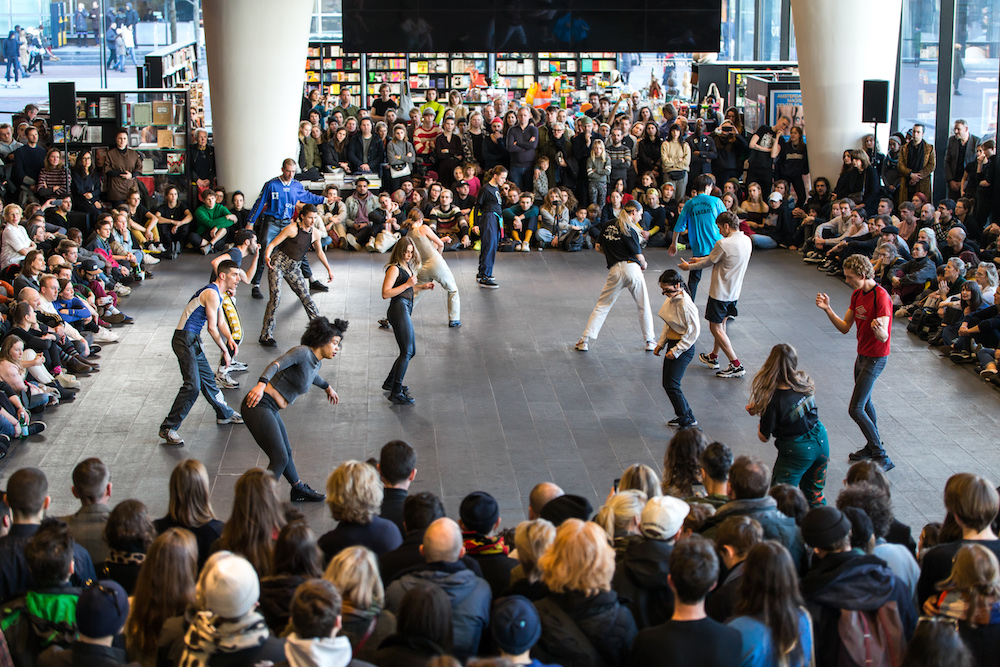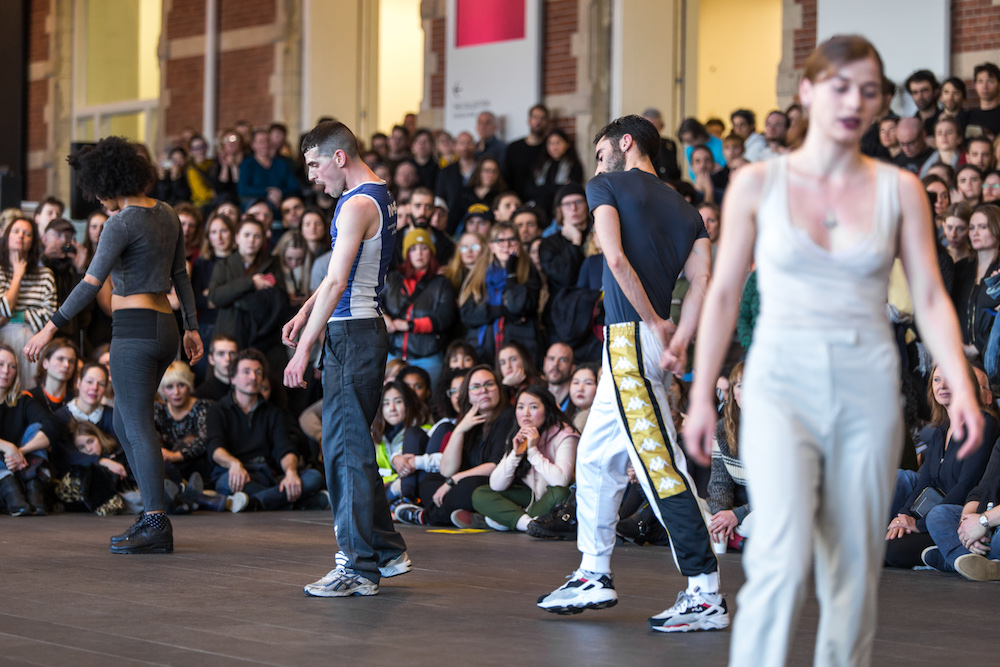In a book titled La Nuit, philosopher Michaël Fœssel analyses the night as a time-space independent from the day. The night he writes about is a place where one can live without witnesses; freed from the tyranny of the day, the subject may chance into unique experiences. This night ceases to exist when one realises: “What am I doing here, still awake?”
Raves are born out of transgressions at nightfall. It is a culture of occasional and spontaneous gathering around music, of refusal of normative structures and of indulgence into collective becomings. Raves produce nocturnal experiences as understood by Michaël Fœssel: spaces with no witnesses. This resistance to being seen has been a survival strategy. Historically, evidence could be used to arrest and punish. But it is also the culture’s raison d’être: raving is a practice of permissiveness and fugitivity. It is formed by behaviours that can only exist in the promise of not being scrutinised by the moral gaze of the day: experiments with identity, abandon, rapture and highs dissent observation. Raves have now often been replaced by licensed clubs and festivals, yet within techno club culture, this tolerant nocturnal vision withstands. In committed parties, there are no mirrors and photography is often banned. Existing only through participation, techno clubbing is hard to grasp and depict out of its context.

Michele Rizzo’s performance ‘HIGHER xtn.’ challenges this resistance to being observed and captured. Rizzo graduated from the School for New Dance Development, Amsterdam in 2011. In 2015 he created ‘HIGHER’ a choreography drawing on his experience of the techno club and inspired by the cathartic power of dance. Initially conceived for the theatre, the work went on to travel to festivals across Europe. Within the exhibition Freedom of Movement curated by Karen Archey at the Stedelijk Museum that ran November 25, 2018 to March 17, 2019, the project evolved into ‘HIGHER xtn.’, a version in which the number of dancers increases each week. The choreography unfolds in the institution’s entrance hall – a site belonging to the regime of the day. Entering is accepting to follow a code of conduct, to be legible and watched. Still, in the atrium, in front of a crowd of observers, the performance dances into existence as a techno moving and knowing thing.
The 40-minutes choreography is inspired by Konijnendans or Cutting Shapes, a Dutch version of the Shuffle. Performers enter one by one to an electronic soundtrack by Lorenzo Senni, gently dancing their way to the centre of the space. The music evolves, complicates and intensifies. What began as an introspective, solitary dance gradually progresses into a synchronised, collective rapture. Face expressions change from composed to exalted; the energy builds up. A feeling of excitement, infectious, spreads from the performers to the audience. ‘HIGHER xtn.’ brings to the museum something from the dead of the night: a glimpse into techno clubbing ways of feeling and being. An achievement that comes against all odds, as Rizzo explains, “Clubbing is an immersive experience that is so specific and works together with the elements of the club: the light, the sound, the vibrations, the people and so on.” The artist recalls his first rehearsal, during which the difficulty of working with club culture as material became manifest, “When we went to the studio to start working on the piece, it felt like we were going to fail.” To navigate this tension, the artist used his experience as a dancer. He studied choreography and could look at the club experience from this perspective, “I started putting into dialogue these two ways of dealing with dance: dance as an art form, which I studied in school, and dance as a nightlife experience, a social dance, an ecstatic state. I realised there was a way to get to some kind of material that sits in between and doesn’t have to be unfaithful to clubbing.”

What, then, is this techno way of feeling and being that the work communicates? Rizzo explains, “Techno is a community that invites you and allows you to feel like you are on your own, and this is what I try to propose to the audience.” The artist suggests this can apply to the museum, “People can occupy the space and be fully dedicated to their own perception.” The gentle and respectful arrival of the performers in space and the repetition of a dance phrase over and over again is the formal, initial form of this proposal. It then expands, “The viewer is confronted with material which after a while disappears. It’s not about the steps anymore. It’s more about something that is behind it somehow.” And as ‘HIGHER xtn.’ evolves into something less tangible, it starts to activate audiences. In the artist’s words, “Something evaporates from the performance, something immaterial. The repetition helps the viewer transition from a state of voyeur to a more visceral way of experiencing the material.” The effect was contagious and the audience came in larger numbers every Saturday. He recalls, “I never experienced the museum in that way. I never saw the museum so alive. Not just alive: simply different. It was truly magical. The space was so charged, especially in the last four performances.”

This radiating effect of ‘HIGHER xtn.’ is one of the reasons behind the Stedelijk Museum purchase of the work for their collection. Karen Archey, who is also Curator of Contemporary Art, Time-based Media at the Stedelijk Museum, shares: “Michele and his work had a huge impact on the museum, and potentially the city at large. I anticipate that ‘HIGHER xtn.’ will become an important part of the museum’s history, marking a time in which thousands of people came together around this performance.” This acquisition raises interesting questions: What happens when a work drawing from fugitive archives enters the museum collection? How is it archived and cared for? How to avoid an ossification that would annihilate its premise? How to enable its capacity – opening the public to individual and collective ways of feeling and moving – remain relevant and understandable in the future? How do stories of rave and club culture inhabit the museum, how can they be institutionalised?
The curator and the artist are currently discussing the ways in which ‘HIGHER xtn.’ could live within the collection. Archey shared how choreography, as an embodied practice, poses specific conservation and documentation challenges that might not exist in other time-based media such as video. “We are currently in an active acquisition process with Michele in which we will determine the best way to create a set of choreographic instructions. Some artists prefer to nominate people as teachers, and others prepare video tutorials as instructions or write everything out as a score – or all of these options”, she explains. Rizzo is currently looking at all possibilities, including inscribing the work into oral lore. “I will try to establish a chain of successors. The people who were involved in the previous edition will be engaging with the new generation. There will be some sort of oral knowledge transferred.”

‘HIGHER xtn.’, which exists as a proposition for learning through embodied knowledge, will live through embodied knowledge. It inhabits the collection as a moving, changing matter, transmitted from bodies to bodies – a rumour in storage, resisting finitude. Within the institution, but not institutionalised. In and out, fleeting and unruly, dancing its way to an endless night.**
Michele Rizzo’s performance ‘HIGHER xtn.’ was presented during Freedom of Movement at Amsterdam’s Stedelijk Museum from November 25, 2018 to March 17, 2019.













